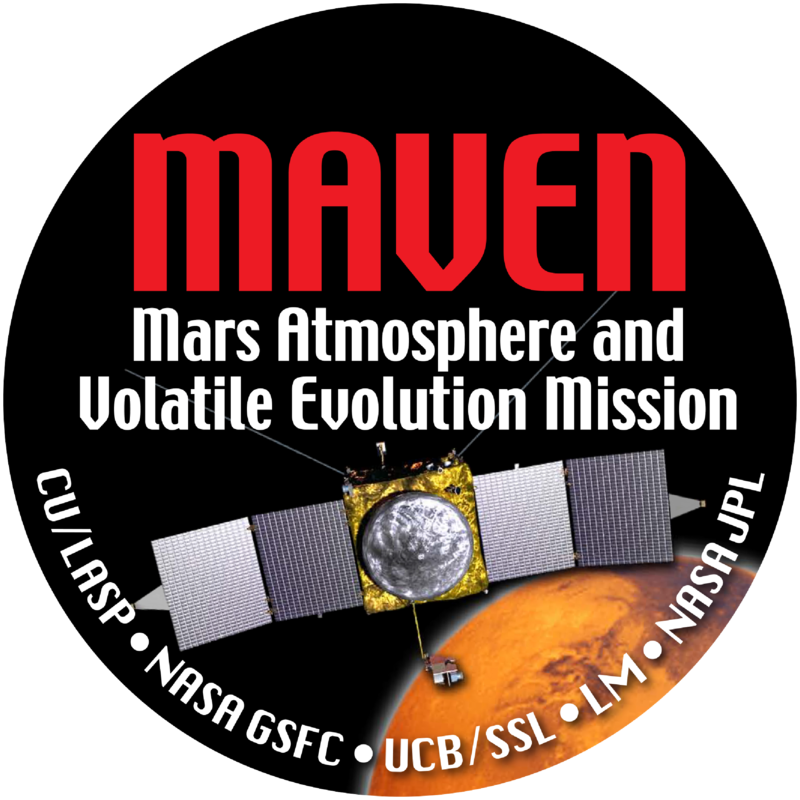My last post dealt with India's homebuilt Mangalyaan Mars satellite. The United States recently launched a Mars probe. Today I am going to discuss the U.S. satellite. The U.S. Mars probe is called MAVEN. This stands for Mars Atmosphere and Volatile Evolution Mission. The satellite was launched on an Atlas V launch vehicle in November of 2013. On September 11, 2014, MAVEN achieved an areocentric elliptical orbit about four thousand miles at its furthest from Mars and about a hundred miles at it closest approach. It will orbit Mars for at least a year gathering and sending back information about the Martian atmosphere.
MAVEN was constructed as part of NASA's Mars Scout Program which was discontinued in 2010. In October of 2013, only seven weeks before the intended launch date, work on the program was suspended for two days because of the shutdown of the federal government in the battle over the budget. The launch could have been delayed for over two years but NASA deemed the project to be too important to be delayed and managed to find emergency funding that enabled the launch to take place as scheduled.
MAVEN was built by Lockheed Martin Space Systems. It is a cube roughly two yards on a side and follows the design of the Mars Reconnaissance Orbiter and Mars Odyssey Mars probes. Maven weights one thousand seven hundred and eighty four pounds with one hundred and forty three pounds of scientific instrumentation as payload. It has two solar panels and is about eleven yards long including the satellite and the panels.
Goals of the MAVEN mission include:
1) Finding out how the Martian atmosphere lost volatile elements such as nitrogen, water, carbon dioxide, ammonia, hydrogen, methane and sulfur dioxide to space.
2) Determining the current state of the upper Martian atmosphere, the Martian ionosphere and the interactions of the upper atmosphere with the solar wind.
3) Measuring the rate at which neutral gases and ions are escaping from the Martian atmosphere and investigating the processes controlling the loss.
4) Determining the ratios of the different stable isotopes that currently exist in the Martial atmosphere.
The scientific instrumentation on MAVEN include:
- Solar Wind Electron Analyzer (SWEA) – measures solar wind and ionosphere electrons
- Solar Wind Ion Analyzer (SWIA) – measures solar wind and magnetosheath ion density and velocity
- SupraThermal And Thermal Ion Composition (STATIC) – measures thermal ions to moderate-energy escaping ions
- Solar Energetic Particle (SEP) – determines the impact of SEPs on the upper atmosphere
- Langmuir Probe and Waves (LPW) – determines ionosphere properties and wave heating of escaping ions and solar extreme ultraviolet (EUV) input to atmosphere
- Magnetometer (MAG) – measures interplanetary solar wind and ionosphere magnetic fields
· Imaging Ultraviolet Spectrometer (IUVS) – measures global characteristics of the upper atmosphere and ionosphere
- Measures the composition and isotopes of neutral gases and ions
The MAVEN mission cost six hundred seventy one million dollars. The Indian Mars probe that arrived in Mars orbit about the same time as MAVEN cost only seventy four millions dollars. Although MAVEN is much more sophisticated and carries more scientific instrumentation, there will be a market for less expensive satellites such as the Indian Mangalyaan spacecraft.
